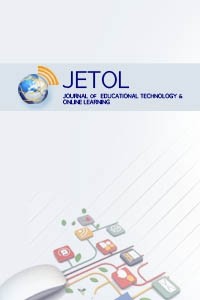Coding activities in IT courses through the lenses of IT teachers
Coding, Information Technology Teachers, Coding Activities in Lessons, using Coding Activities
Coding activities in IT courses through the lenses of IT teachers
Coding/Programming, Information Technology Teachers, Coding / Programming Activities in Lessons, Using Coding/Programming Activities.,
___
- Aydın, M., & Sunbul, A. M. 2012. “Effect of the Verbal Mnemonics on Students’ Achievements and their Attitudes”, Procedia-Social and Behavioral Sciences, 47, 1506-1510.
- Baumann, K. A. (2016). Computer security in elementary schools: Faculty perception of curriculum adequacy. Northcentral University.
- Babbie, E. R. (2016). The practice of social research (14th ed.). Cengage Learning.
- Büyüköztürk, Ş., Akgün, Ö. E., Demirel, F., Karadeniz, Ş., & Çakmak, E. K. (2015). Bilimsel araştırma yöntemleri [Scientific research methods]. Pegem Akademi.
- Bers, M. U. (2020). Coding as a playground: Programming and computational thinking in the early childhood classroom. Routledge.
- Calder, N. (2010). Using scratch: An integrated problem-solving approach to mathematical thinking. Australian Primary Mathematics Classroom, 15(4), 9-14.
- Copley, J., & Ziviani, J. (2004). Barriers to the use of assistive technology for children with multiple disabilities. Occupational Therapy International, 11(4), 229-243.
- Çetin, E. (2012). Bilgisayar programlama eğitiminin çocukların problem çözme becerileri üzerine etkisi [The effect of computer programming education on children's problem-solving skills]. Unpublished master's thesis, Gazi University, Ankara, Turkey.
- Çam, E., & Kıyıcı, M. (2022). The Impact of Robotics Assisted Programming Education on Academic Success, Problem Solving Skills and Motivation. Journal of Educational Technology And Online Learning. doi: 10.31681/jetol.1028825
- Demirer, V., & Nurcan, S. A. K. (2015). Türkiye'de Bilişim Teknolojileri (BT) Eğitimi ve BT Öğretmenlerin Değişen Rolleri [Information Technology (IT) Education in Turkey and the Changing Roles of IT Teachers]. Uluslararası Eğitim Bilimleri Dergisi, (5), 434-448. https://doi.org/10.11648/j.sjedu.20150305.19
- Dewey, M., Zimmermann, E., Laule, M., Rutsch, W., & Hamm, B. (2008). Three-vessel coronary artery disease examined with 320-slice computed tomography coronary angiography. European Heart Journal, 29(13), 1669-1675. https://doi.org/10.1093/eurheartj/ehn228
- Gander, W., Petit, A., Berry, G., Demo, B., Vahrenhold, J., McGettrick, A., ... & Meyer, B. (2013). Informatics education: Europe cannot afford to miss the boat. ACM. Retrieved from http://europe.acm.org/iereport/ie.html.
- Grout, V., & Houlden, N. (2014). Taking computer science and programming into schools: The Glyndŵr/BCS Turing project. Procedia-Social and Behavioral Sciences, 141, 680-685.
- Kafai, Y. B., & Burke, Q. (2015). Connected Code: Why Children Need to Learn Programming. Cambridge, MA: MIT Press.
- Karanfiller, T., Göksu, H., & Yurtkan, K. (2017). Özel eğitim gereksinimi olan öğrenciler için temel kavram öğretimi mobil uygulama tasarımı. Eğitim ve Bilim, 42(192), 213-226.
- Kester, L., Kirschner, P. A., & Corbalan, G. (2007). Designing support to facilitate learning in powerful electronic learning environments. Computers in Human Behavior, 23(3), 1047-1054. https://doi.org/10.1016/j.chb.2004.12.013
- Li, Y., & Li, K. (2018). Integrating coding into secondary school curriculum: A study of teacher perceptions and practices. Educational Technology Research and Development, 66(5), 1195-1215.
- Liu, Y., Chiu, P. S., & Chou, P. N. (2017). The study of the use of programming in elementary and middle school education. Eurasia Journal of Mathematics, Science and Technology Education, 13(7), 3303-3317. https://doi.org/10.12973/eurasia.2017.00739a
- Milli Eğitim Bakanlığı. (2019). Öğretim Programları. Retrieved from http://mufredat.meb.gov.tr/ProgramDetay.Aspx.
- Neuman, W. L. (2014). Social research methods: Qualitative and quantitative approaches. Boston, MA: Pearson.
- Nunez, M. (2018). Is coding the blue-collar job of the future? CBS News. Retrieved from https://www.cbsnews.com/news/is-coding-the-blue-collar-job-of-the-future/.
- Noor-Ul-Amin, S. (2013). An effective use of ICT for education and learning by drawing on worldwide knowledge, research, and experience. In M. Ally & A. Tsinakos (Eds.), ICT as a change agent for education (pp. 1-13). Athabasca University Press.
- NMC/CoSN Horizon Report. (2017). The NMC/CoSN Horizon Report: 2017 K-12 Edition. International Society for Technology in Education.
- Resnick, M., & Silverman, B. (2005). Some reflections on designing construction kits for kids. In Proceedings of the 2005 Conference on Interaction Design and Children (pp. 117-122). ACM. https://doi.org/10.1145/1109540.1109558
- Yecan, E., Özçınar, H., & Tanyeri, T. (2017). Bilişim teknolojileri öğretmenlerinin görsel programlama öğretimi deneyimleri [Experiences of information technologies teachers on visual programming education]. İlköğretim Online, 16(1), 49-66. https://doi.org/10.17051/ilkonline.2017.268999
- Wachenchauzer, R. (2004, October). Work in progress-promoting critical thinking while learning programming language concepts and paradigms. In 34th Annual Frontiers in Education, 2004. FIE 2004 (pp. F4C-13). IEEE.
- Wu, C. C., & Lee, G. C. (2004). Use of computer-mediated communication in a teaching practicum course. International Journal of Science and Mathematics Education, 2(4), 511-528. https://doi.org/10.1007/s10763-004-7465-3
- ISSN: 2618-6586
- Yayın Aralığı: Yılda 3 Sayı
- Başlangıç: 2017
- Yayıncı: Gürhan DURAK
Academic engagement experiences of pre-service teachers during the Covid-19 online education process
Büşra Zeynep ARSLAN, Erva BULUT, Burcu ÖZCAN, Fadime URAL, Funda BARUTÇU YILDIRIM
Sinem Can ERÇOK GÜLER, Recep CENGIZ, Erkan GÜNAY
Social media use among U.S. college students attending a midwestern university
Cebrail KARAYİGİT, Jose PARLADE
How Covid-19 taught teachers how to teach online– a case study at the Open University of Mauritius
Online learning and teaching experiences of preservice science teachers during Covid-19 pandemic
Nagihan TANIK ÖNAL, Nezih ÖNAL
Parent opinions on distance education practices in the emergency remote education period in Turkey
A validity and reliability study of the Turkish computational thinking scale
Students’ experiences of learning in virtual classrooms facilitated by Google Classroom
Coding activities in IT courses through the lenses of IT teachers
